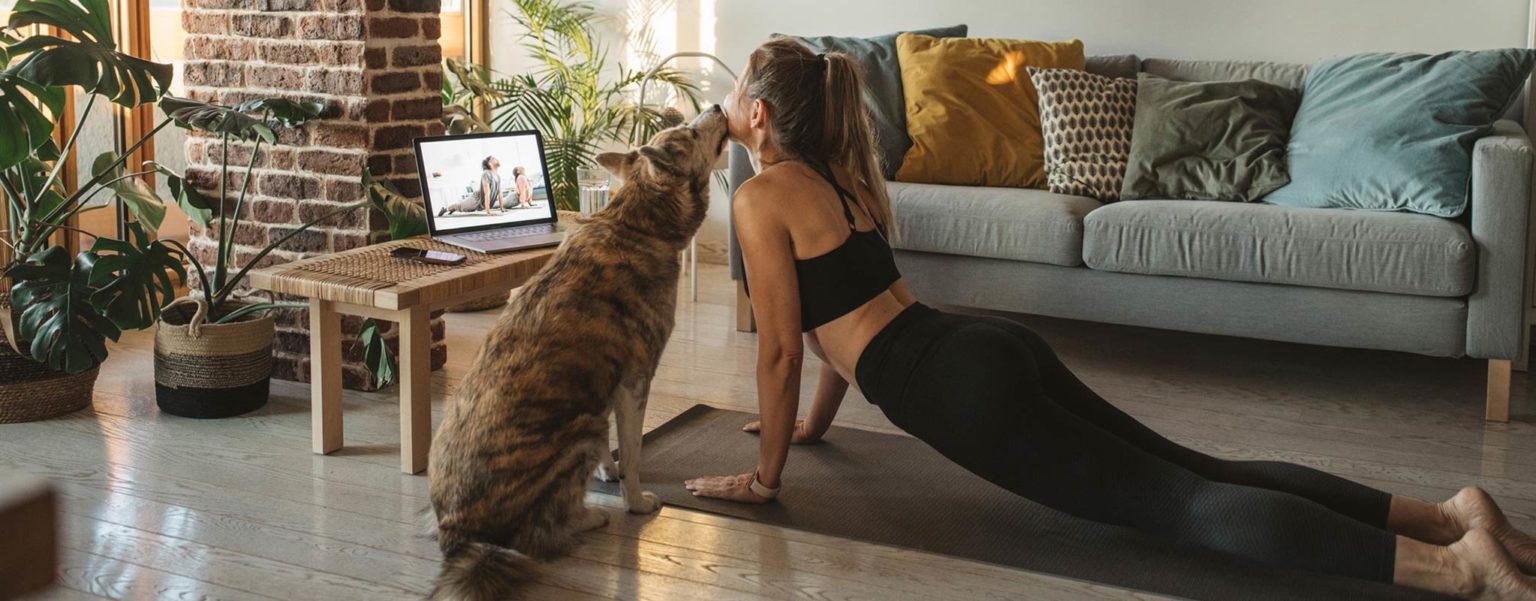Moving boxes and packing once a year isn’t the only time your body should get exercise. In fact, according to the CDC, “People who are physically active for about 150 minutes each week have a 33% lower risk of all-cause mortality than those who are physically inactive.”
It can be difficult to get on a regular workout schedule, especially if you’re renting far away from your workplace or a gym. Don’t worry though — we’re here to help because the only thing you should be sweating is your workout!
We’ve done the homework for you and listed 17 exercises you can do from the comfort of your rental space or wherever you might be. These exercises are quiet and won’t make your neighbors complain to management. You can also do them in small spaces, which minimizes the risk of damage and impacting your lease agreement.
Our guide documents the best apartment workout equipment and offers unique storage tips. And if you’re not sure about purchasing exercise equipment yet, no worries. We’ve also included household items you can strategically supplement for workout equipment.
Read the article below to begin your exercise journey or get a quick summary by viewing our infographic below.
1. Arm Exercises
Working out your arm muscles multiple times a week is a good way to build definition. Even better, you can confidently answer “yes” on job applications when they ask if you can lift objects more than 35 pounds. Here are the best arm exercises you can do at home.
Curls
Curls are a great way to get the blood flowing to your biceps and forearms. You can do curls with either dumbbells or barbells.
- Step 1: Start with your arms by your side, weights in hand.
- Step 2: Alternating arms, curl each arm up by bending at the elbow while keeping your back straight and your eyes looking forward.
The weights can be either parallel or perpendicular to your body. You can also do curls sitting down or standing up.
Increase difficulty: While standing, put the metal or rubber ends of the weights together and curl both arms together in one motion.
Household alternative: Replace dumbbells with gallons of water or cans of food.
Tricep Extensions
Tricep extensions are one of the best ways to target your triceps and your latissimus dorsi (lat) muscles. You can either sit or stand when doing this exercise. If standing, bend your knees a bit.
- Step 1: Start by making a triangle with your hands at the base of a dumbbell and lifting the dumbbell over your head.
- Step 2: Your arms should be hugging your ears and elbows pointing forward.
- Step 3: Then, lift the dumbbell up and down behind your head while keeping your elbows forward and pinched close to your ears.
Increase difficulty: Do the same activity with one arm holding the dumbbell.
Household alternative: Replace dumbbells with gallons of water or laundry detergent.
Dips
Dips are another exercise that targets your triceps. However, they also work out the front deltoids on your shoulders and chest. You’ll need a sturdy elevated surface such as a chair or couch. If you’re using a chair, especially one with wheels, make sure it’s against a wall.
- Step 1: Begin by sitting on the edge of an elevated surface.
- Step 2: Next, extend your legs outward with your heels against the floor.
- Step 3: Then, while keeping your legs straight and your hands anchored to the chair, lower your body. Your elbows should go to a 90-degree angle.
Increase difficulty: Place your hands closer, which will isolate your triceps more.
Household Alternative: If you don’t have a workout bench use a sturdy chair or couch.
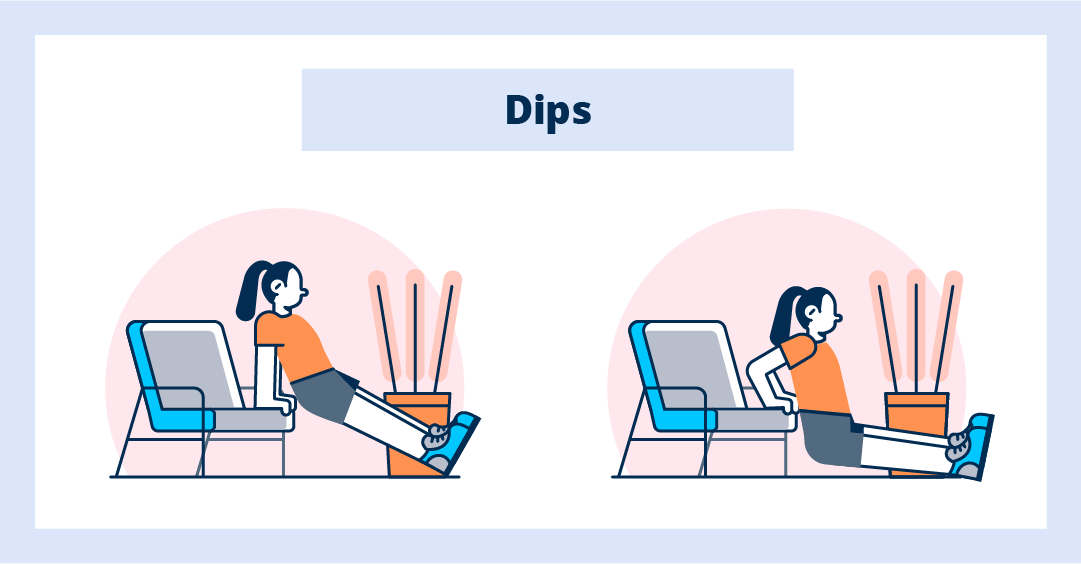
2. Shoulder Exercises
Nearly every upper-body exercise involves shoulder muscles to some extent. Doing shoulder exercises can help treat and prevent injuries and improve your posture. Below are various exercises that target different parts of the shoulder. These exercises will make lifting heavy objects feel like a breeze, especially when tidying your home.
Shoulder Shrugs
Shoulder shrugs target your trapezius muscles, which increases strength and stability in your neck, upper back and shoulders. They’re a simple and small movement, but quite effective. They should also be done with heavier weights.
- Step 1: Start by standing between your dumbbell weights or a barbell.
- Step 2: Then, squat down and firmly grab your weights, picking them up in a deadlift motion, primarily relying on your legs.
- Step 3: With your arms straight in front of you, arch your back slightly and pinch your shoulder blades together.
- Step 4: Finally, lift your shoulders up and down while keeping your shoulder blades pinched.
Increase difficulty: Do the exercise sitting down on the corner of your bed or a stool.
Household alternative: If you don’t have heavy dumbbells, you can do shoulder shrugs with loaded suitcases or duffle bags. Just make sure your arms aren’t too far from your body.
Military Press
The military press, also known as an overhead or shoulder press, works out your entire deltoid along with your tricep muscles. You can do shoulder presses with dumbbells, a weighted barbell or resistance bands. You can also do this exercise either sitting or standing; if standing, you’ll be engaging your back muscles and abs more. Below is a description of how to do military presses with dumbbells.
- Step 1: Begin either sitting or standing. If sitting, it’s useful to have a chair with a back.
- Step 2: Next, lift the dumbbells so that they’re aligned with your ears. Your palms should face the same direction as you’re looking, and your elbows should be bent at a 90-degree angle and slightly lower than your shoulders.
- Step 3: Then, push the dumbbells up while keeping your wrists straight and slowly lower down until your elbows hit a 90-degree angle again.
Increase difficulty: Do this exercise while standing to activate more muscle groups.
Household alternative: You can supplement dumbbells with 14- or 28-ounce cans of food.
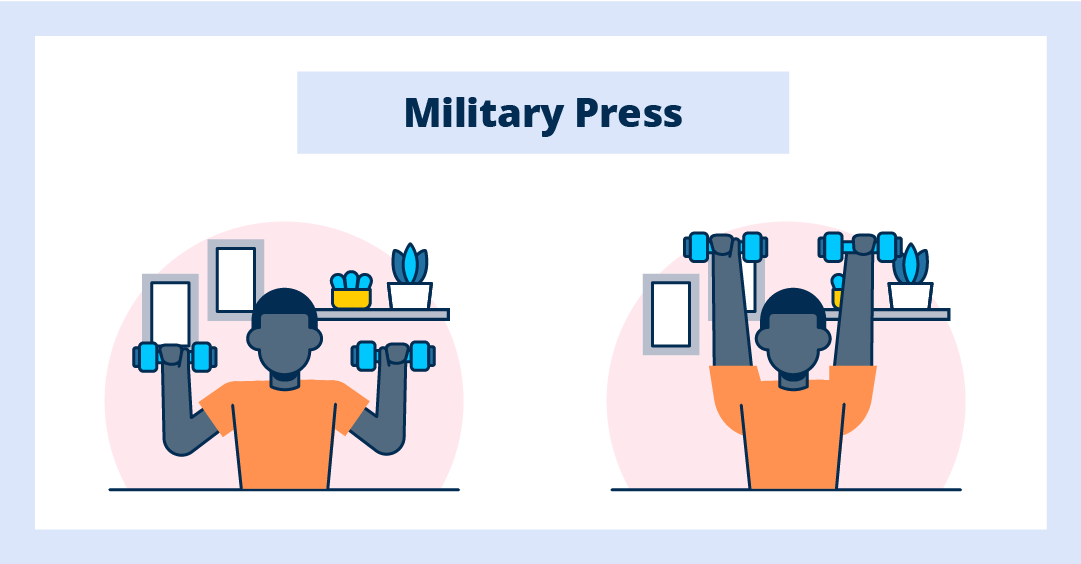
3. Chest Exercises
Chest exercises will also help stabilize your shoulder joint. They also often work out your shoulders and triceps and secondary muscles. Below are two straightforward chest exercises to do.
Pushups
If you ever took a PE class, you’ve likely done pushups before. They’re a classic exercise because they not only work out your chest but also your shoulders, triceps and abdominal muscles.
- Step 1: Start on your stomach with your hands, knees and toes on the ground. Your hands should be shoulder-width apart and directly in front of your shoulders.
- Step 2: Next, lift your body up so you’re in a plank position with your hands beneath you. You’ll be supported by your hands and toes. Your spine should also be in a straight line.
- Step 3: Then, lower your body down until it almost touches the floor. Take a quick pause at the bottom before pushing yourself back up. Make sure your shoulder blades are pinching when going down.
If this exercise is too difficult or your form becomes poor, do the exercise with your knees on the ground and your feet crossed behind them.
Increase difficulty: Put your hands together in a diamond shape to isolate your triceps or place your hands wider for a more difficult chest exercise.
Household alternative: Pushups can be done on any level surface. They’re more comfortable if done on top of a carpeted area, towel or yoga mat.
Dumbbell Floor Press
The dumbbell floor press is another solid chest and tricep exercise. It’s ideal for those who have shoulder injuries or discomfort since it primarily focuses on your chest versus your labrum or front deltoids. Think of this exercise as an inverted pushup with weights in your hands.
- Step 1: Begin by sitting in between your dumbbells and then placing one end on top of your thighs.
- Step 2: Then, roll backward while holding the weights in each hand. Your arms should be by your side and tucked in at a 45-degree angle to your body with your triceps touching the floor. The dumbbells should be under your arms and hovering next to your chest.
- Step 3: Put your knees and feet flat on the floor.
- Step 4: While keeping your wrists locked, turn the weights slightly inward.
- Step 5: Finally, push the dumbbells up, touching the tips of them together above your sternum.
- Step 6: Repeat this exercise for the desired repetition.
Increase difficulty: Extend your legs out for less core stability.
Household alternative: If you don’t have dumbbell weights, a full suitcase can serve as weights.
4. Back Exercises
Your back is one of the most important areas to work out because it helps keep the connective fibers to ligaments and tendons flexible. Back exercises also help secure stability with the spine and improve posture. The below exercises will target and strengthen different regions of the back.
Supermans
Supermans are an easy exercise to do that require no fitness equipment. This exercise is great for strengthening your mid and lower back while also engaging your glutes. A yoga mat, towel or carpeted area are recommended.
- Step 1: Start by lying face down on the floor with your arms stretched straight out over your head.
- Step 2: Then, lift your arms, shoulders and chest off the ground. Simultaneously, lift your legs off as well. You should be balancing on your pelvis and stomach.
- Step 3: Hold at the top for one to three seconds and then repeat.
Increase difficulty: Do the same movement but with opposite limbs — e.g., lift your left arm and right leg and then alternate to your right arm and left leg.
Household alternative: You can hold a book between your hands or feet to increase difficulty.
Bent-Over Lateral Raises
Bent-over lateral raises are a bit more advanced than the other exercises here but are excellent for developing the rear deltoids, which people often forget to exercise. They also work out your middle and lower trapezius muscles. The step-by-step instructions are with dumbbells while standing. Note, this movement needs to be done in a controlled manner.
- Step 1: Start by standing between your dumbbell weights.
- Step 2: Then, squat down and pick up the dumbbell weights. Your feet should be shoulder-width apart and knees slightly bent.
- Step 3: Next, bend at the hip while keeping your spine straight. Your upper body should be at a 45-degree angle and your head tucked down and looking at the ground.
- Step 4: With a slight bend in your elbows, lift your arms up and out until your hands are even with your back. Pinch your shoulder blades at the top. Lower your arms and the weight back down to the starting position.
Increase difficulty: Do the exercise sitting down, which further isolates the rear deltoids.
Household alternative: You can use two books of equal weight instead of dumbbells. Hold the books by their spine with the back of the book against your inner forearm.
Single-Arm Dumbbell Row
Single-arm dumbbell rows are an isolating movement and exercise. They target your rear deltoids, latissimus dorsi (lats) and trapezii. They’re best to do after other warm-up or less intense exercises. You can do this exercise either sitting or standing. We’ll describe the exercise from a standing position.
- Step 1: Take a one-step lunge backward. Your front knee should have a nice bend in it while your back foot is flat on the ground with your toes pointing away from your body. Think Warrior Two pose in yoga.
- Step 2: Lean forward slightly and place your hand on top of your front thigh, right above the knee.
- Step 3: Next, grab your dumbbell with your free hand and lift it upward and back in one motion.
- Step 4: Lift the dumbbell up to your rib cage, squeeze your shoulder blade toward your spine at the top of the exercise, then slowly release down. While doing this exercise, make sure you have a neutral spine and that your abdominal muscles are tight.
Increase difficulty: You can increase the difficulty of this exercise by doing it on the side of your sofa or bed. Just make sure you can easily touch the ground with one leg and can keep a neutral spine position.
Household alternative: Milk or water jugs with handles are great alternatives to dumbbells.
5. Leg Exercises
Your legs have some of the largest muscles in your body. Most functional exercises and sports activities begin with or incorporate leg movements. Therefore, it’s important to work out your legs, especially if you participate in sports activities. Below are fairly simple leg exercises that pack a punch. You’ll feel more empowered when moving boxes or lifting heavy objects around the household.
Squats
Standard squats are one of the most important and popular leg exercises. In fact, most athletes include squats in their workout due to them working out your quadricep muscles, glutes, hamstrings and hip abductors.
- Step 1: Begin by standing with your feet shoulder-width apart. Your toes should be pointing ever so slightly outwards.
- Step 2: Next, lower your body down until your thighs are parallel to the floor. There should be a 90-degree angle in the back of your knees.
- Step 3: Now push back up, driving your feet into the ground. You can extend your arms forward if you’re having trouble balancing.
- Step 4: When squatting, make sure you go at least 90 degrees and that your knees don’t go past your toes. Both help to prevent injury and are better for your knees.
Increase difficulty: To increase difficulty, simply hold dumbbells in each hand or one large dumbbell with both hands at chest level. You can also use a weighted barbell or vest.
Household alternative: A weighted vest can be easily substituted with a backpack.
Bulgarian Split Squat
This leg exercise is similar to the squat but allows you to go lower, which puts more emphasis on your quads. It also emphasizes balance, which helps build and strengthen stabilizer muscles in your leg.
- Step 1: Begin by standing one to two feet in front of a chair, couch or sofa. You want the elevated surface to be knee-level — above your mid-calf but below your mid-thigh.
- Step 2: Next, stretch one leg backward and place your foot on the elevated surface. You can lay the top of your foot on the elevated surface or have your toes be the main contact point.
- Step 3: Then, position your front foot to where you’re balanced and can stand up straight.
- Step 4: Now, lower your body until your front thigh is parallel to the ground. Your back knee should be near the ground, but not touching it. Make sure your front knee is not wobbling side to side.
Increase difficulty: To increase difficulty, simply hold dumbbells in each hand or hold one large dumbbell with both hands at chest level.
Household alternative: Again, you can substitute a weighted vest or dumbbells with a backpack.
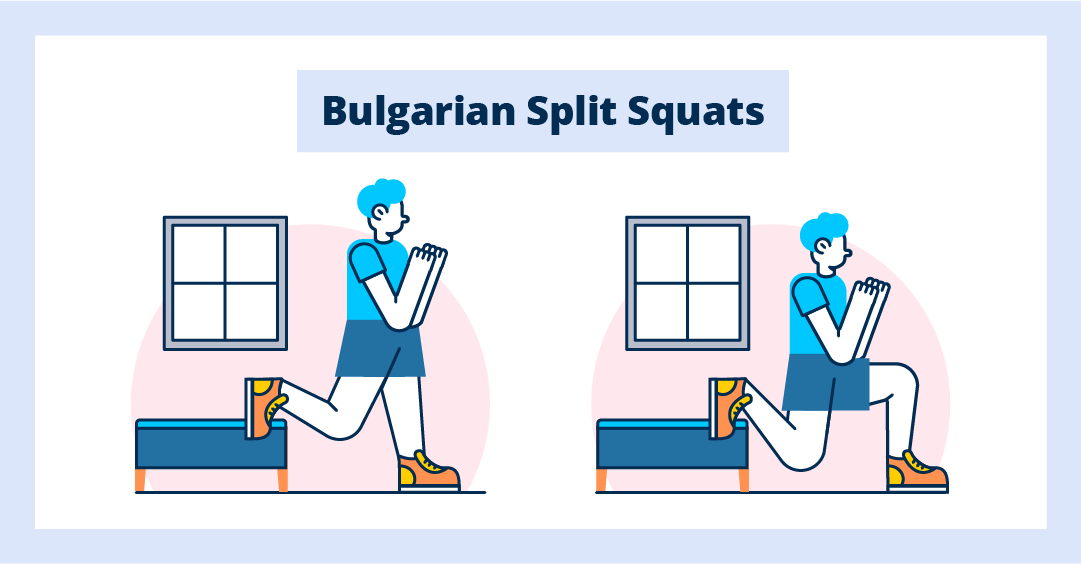
Calf Raises
Calf raises are another simple leg exercise that you can do without weight or equipment. Just make sure to stretch your calves before and afterward.
- Step 1: Start by standing in a doorway and holding the frame for balance.
- Step 2: Then, go up and down on your toes, lifting your heels off the ground. Your body should be rising and falling by your calf muscles only. Hold at the top for one second.
Increase difficulty: You can increase the difficulty by standing on an elevated surface or by holding dumbbell weights.
Household alternative: You can stand on the bottom step of a stairwell.
Glute Bridges
Per the name, glute bridges target your glutes. They also develop your hamstrings and lower back muscles. Glute bridges are an easy exercise that you can do between work calls or on your lunch break.
- Step 1: Start by lying with your back against the floor. Your arms should be by your sides with your palms down against the ground.
- Step 2: Now, move your feet backward so that your heels are almost touching your glutes. Tighten your abdominal muscles.
- Step 3: While keeping your abs engaged, raise your hips up until your body makes a straight line from your knees to your shoulder. Repeat.
Increase difficulty: You can increase the difficulty by doing glute bridges on one leg. Raise the other leg straight up in the air.
Household alternative: You can stand on the bottom step of a stairwell or on a step stool. If using a step stool, place large books or other weights to counter your weight.
6. Abdominal Exercises
Abdominal muscles, commonly referred to as abs, are a very important area of the body to work out. Strong abs can improve your posture by re-aligning and strengthening the muscles in your lower back. Here are a few core exercises you can do either daily or multiple times a week.
Planks
Planks are both a strength and an endurance exercise. They’re great for building core strength while also putting positive tension on your shoulders and chest. Here’s how to do a plank correctly:
- Step 1: Start in a fully extended pushup position. Your hands should be flat on the ground and stacked under your shoulders. You should be looking straight down between your hands or slightly forward, whichever is more comfortable. Just make sure your neck is in line with your spine.
- Step 2: Tighten your glute and ab muscles. Hold for anywhere from 15 seconds to a minute or more.
- Step 3: You can also do this exercise on your elbows and forearms. Simply start in the same pushup position and lower your upper body to your forearms and elbows.
Increase difficulty: You can increase the difficulty by doing the straight-arm plank or, if doing the elbow plank, turning your hands upside down so the back of your hands are on the ground. You can also place a weight in the center of your back.
Household alternative: If you want to add weight, have someone place a bag of dry rice or beans in the middle of your back, just below the shoulder blades.
Lying Leg Raises
A good exercise to target your lower abdominal muscles is leg raises, which are easy to do and require no gym equipment.
- Step 1: Start by lying with your back against the ground.
- Step 2: Then, raise your legs straight up and together, bending at the waist.
- Step 3: Now, lower your legs halfway or all the way toward the floor. Just make sure your legs do not touch the floor. Repeat this movement.
- Step 4: If you’re uncomfortable, you can put your palms down under your lower back for cushioning.
Increase difficulty: To increase difficulty, you can hold the fully extended position for longer or go slower on the downward movement.
Household alternative: You can place a bag of dried rice or beans between your feet. This will work out your abs more and it will activate your hip and thigh muscles.
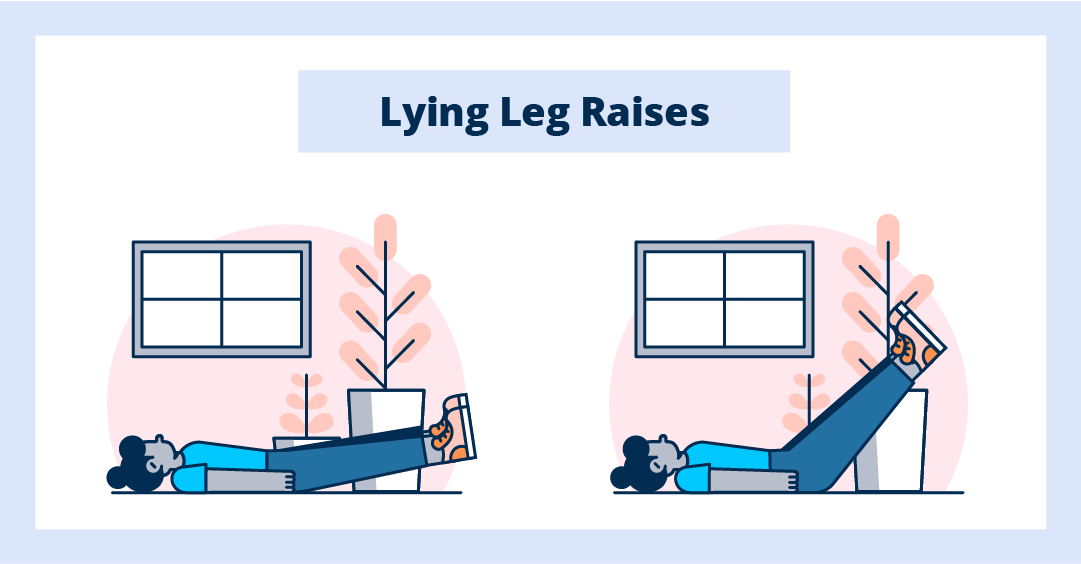
Russian Twists
Russian twists are a nice core burner exercise. They not only work out your core abdominal muscles but also your oblique muscles. They’re a bit tricky at first, but this step-by-step guide will help you master them in no time.
- Step 1: First, start in a seated position with your knees bent in front of you and your feet flat on the floor.
- Step 2: Then, lean backward so that your back is at a 45-degree angle with the floor. While you’re leaning back, your feet should elevate off the ground.
- Step 3: Now, move your upper body and hands side to side. Keep your head and neck facing forward.
Increase difficulty: An easy way to increase difficulty is to hold a dumbbell or medicine ball in your hands as you’re twisting side to side.
Household alternative: Replace the dumbbell or medicine ball with a large book or a heavy bag of dried food.
The Best Exercise Equipment for Small Spaces
To get a full-body workout and do all of the above-listed exercises, you only need a few key pieces of exercise equipment. You’re also in luck because right now it’s much easier to acquire at-home workout equipment than during the early stages of the COVID-19 pandemic.
Small Fitness Equipment
These small items are great for home workouts and they’re fairly easy to store. You can use them in a variety of different workouts and exercises.
- Resistance bands: Resistance bands can be used in a variety of ways and offer extra tension when working out, doing physical therapy or stretching. There are several types of resistance bands, so do your research to help decide which are best for you and your exercise goals.Dumbbell weights: Dumbbell weights are all around very practical to use. You can use them in nearly every exercise mentioned above. We recommend getting a set of small ones, medium-weight ones and either a set of heavy ones or a singular heavy dumbbell. Having this variety of weight will be beneficial to your at-home workout program.
- Barbell and weighted plates: You can also purchase a barbell and weighted plates. Note, though, that these often cause a lot of noise and can be awkward to use within the home. We also only recommend purchasing them if you have a garage, an outdoor space or a way to dampen the noise. If you’re extremely concerned about possible noise violations or upset neighbors, invest in rubber-coated plates.
- Stepping stool: A stepping stool is a fantastic all-in-one piece of exercise equipment. You can use it for leg workouts, pushups, tricep dips and other exercises. It’s quite versatile and can also double as a weight rack.
Stretching and Rehab Equipment
Working out isn’t all about lifting weights and doing exercises. One of the most important portions of your workout should be stretching before and after your exercises. Stretching reduces the risk of injury and helps your muscles relax and repair properly. Stretching can also lower your blood pressure. Here is some of the best exercise equipment for stretching and rehab.
- Yoga mat: A yoga mat makes stretching on a hard floor much easier and comfortable. Not only does it reduce the risk of slipping, which can cause injury, but it also adds some additional padding.
- Yoga block: A yoga block helps with various yoga positions and moves. It often helps with stability and can prevent sudden movements or injuries.
- Stretching bands: Stretching bands are a type of resistance band. They’re typically not as thick and have more flexibility and give, which is beneficial to stretching.
- Foam roller: A foam roller helps to reduce and relieve muscle tension, soreness and inflammation. Foam rollers also help stretch and loosen the fascia, which is the connective tissue that surrounds and holds muscles, organs, nerve fibers and bones in place. Foam rollers come in different sizes, densities and textures. Make sure to research which one is best for you.
- Lacrosse ball: A lacrosse ball is a dense rubber ball that can be used as an alternative to a foam roller for small areas of the body. They’re also great for standing on and massaging your feet.
Larger Fitness Items
Sometimes you need larger fitness equipment, especially if you have a two-bedroom apartment or are renting a townhouse or multi-family home. These items take up a large space, but if you shop smart, they’re still fairly quiet.
- Stationary bike: Some people love biking but can’t do it outside as much as they want due to traffic or weather conditions. A stationary bike takes up fairly little space and is great to hop on and ride after sitting all day in the office or at home.
- Treadmill: If you’re a runner, then treadmills are for you. They’re likely best for ground-floor units since they can still be noisy for those living under you. You can also purchase anti-vibration treadmill mats to reduce the noise and protect floors from damage.
- Rowing machine: Rowing is a full-body workout. Rowing machines are very practical. If you have vaulted ceilings, you can store some rowing machines up and down to save on space. To reduce noise, consider purchasing a water-powered or electrical rowing machine. The ones with built-in fans can be quite loud.
Tips and Tricks for Storing Fitness Equipment in Your Apartment
Whether you’re living in a small studio, a one-bedroom apartment or a house with multiple roommates, it can be difficult to find and organize storage space. Without a designated workout space or converted garage gym, storing exercise equipment becomes even more challenging. Below are a few tips and tricks on where to store your exercise equipment.
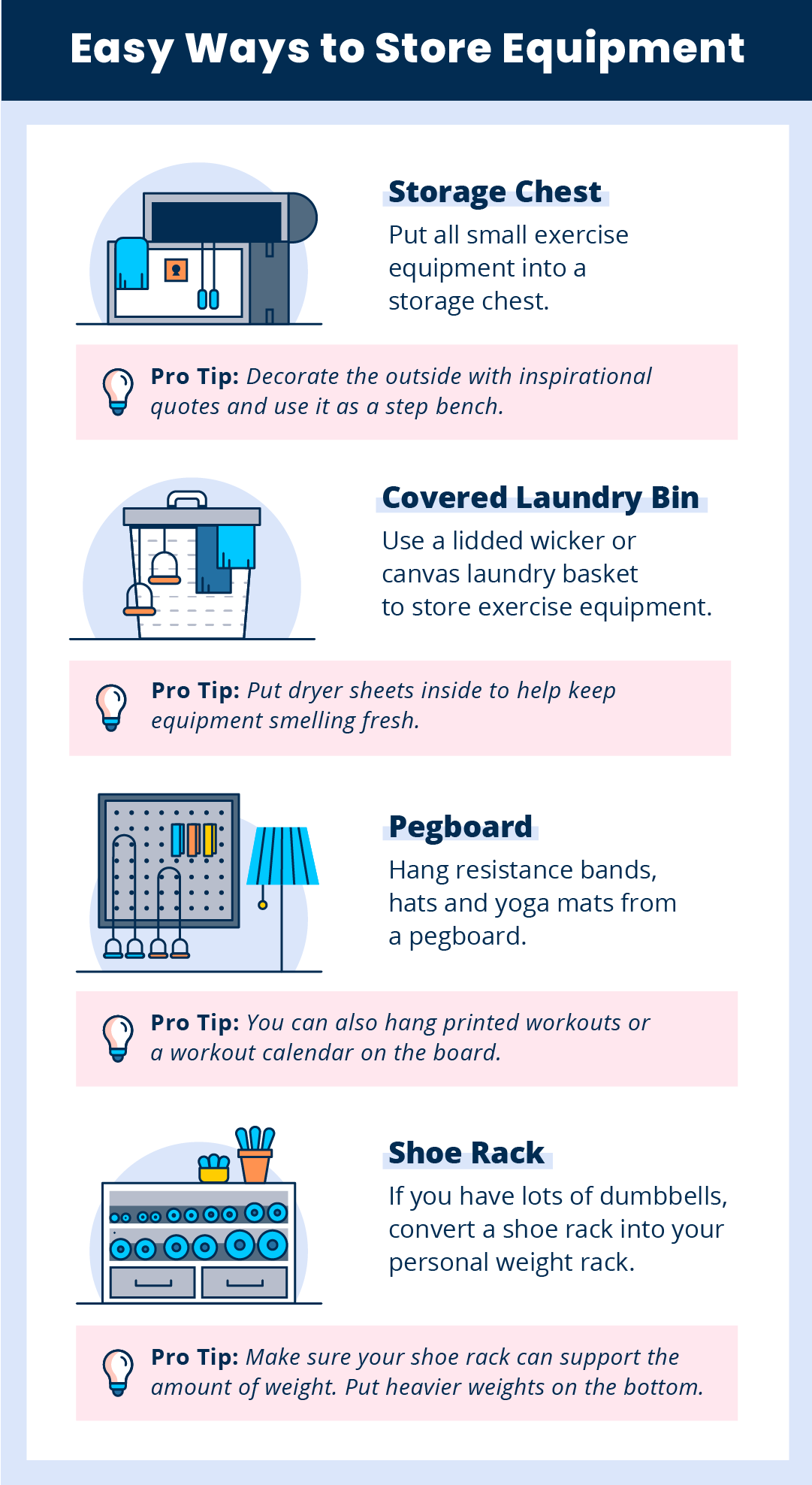
- Storage chest: If you have an unused storage chest, use it as a place to store all of your workout equipment. You can put dumbbells, resistance bands, small foam rollers and yoga mats in it. Additionally, if the top is sturdy enough, you can use the storage chest as a workout bench or step bench.
- Cubbies or bins: Another storage option is to install a cubby space or canvas bins. These will also help you organize your equipment into different categories, and you can add labels to the fronts of the bins.
- Shoe rack: If you have enough storage or shelves for your shoes, then convert your shoe rack into a weight rack. Double-check the amount of weight the shoe rack can hold, and we recommend placing your heaviest weights on the bottom shelf.
- Pegboard: A pegboard serves as a great option for hanging equipment. You can hand your workout headphones, towels, resistance bands, sweatbands, hats and even shoes or yoga mat if large enough.
- Covered laundry bin: Another storage option is to purchase or convert a covered laundry bin. Make sure that it’s not too deep so that getting heavy weights out of the bottom won’t be an issue. You can also place dryer sheets inside to keep items smelling fresh and to help deodorize the room.
Household Alternatives to Workout Equipment
Perhaps you’re not sure you’ll stick to your at-home workout or simply don’t have the budget or room for exercise equipment. No worries — you can use lots of household items as alternatives to exercise equipment. Below is a visual detailing a few alternative options you likely already have lying around the house.
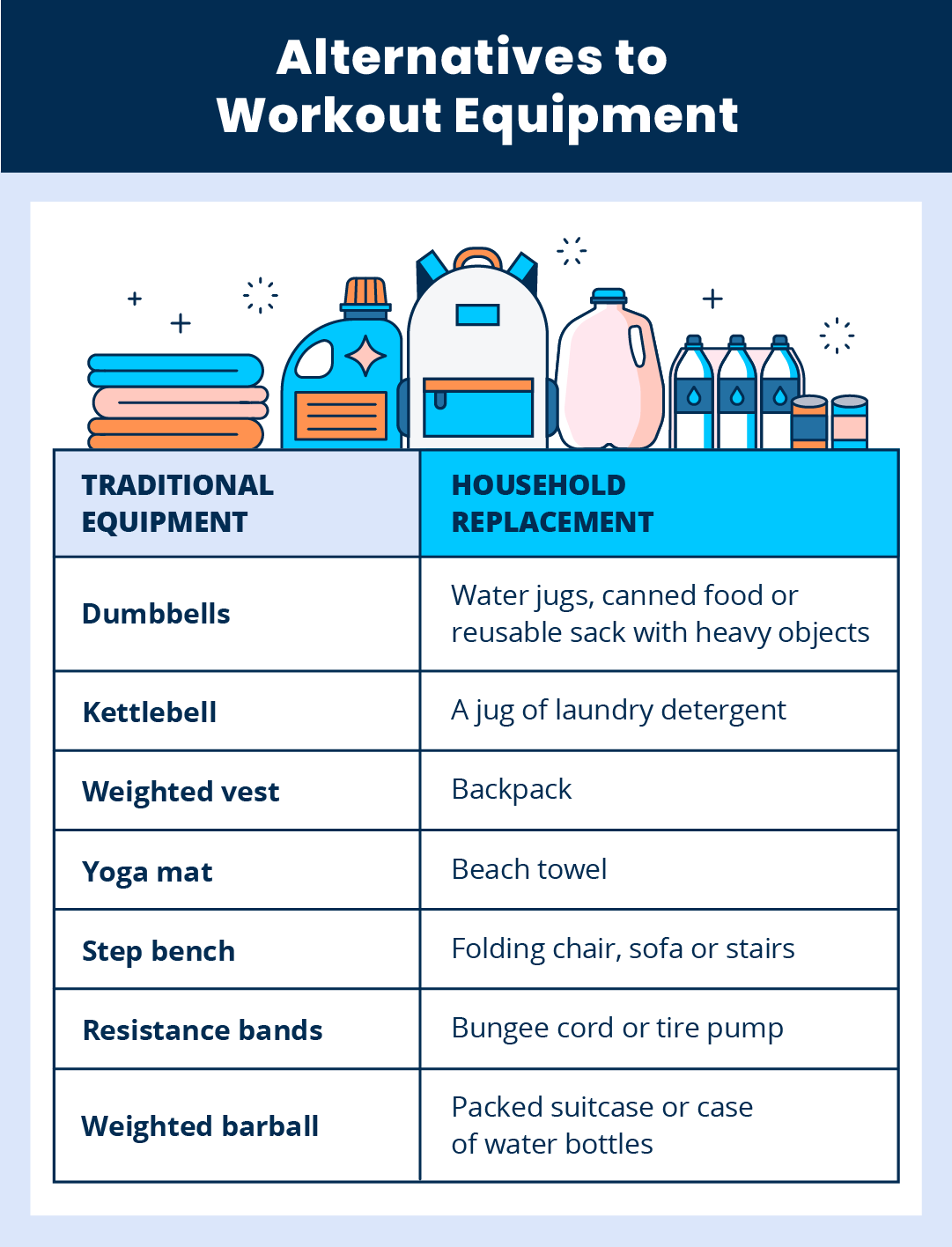
- Dumbbells: There are plenty of household objects that you can substitute for dumbbell weights. You can use canned food for light weights and filled water jugs for heavier weights. Additionally, you can customize weight by filling a reusable sack with books or dried goods.
- Kettlebell: Instead of purchasing a kettlebell, use a large container of laundry detergent. Just make sure that the lid is secured correctly and tightly.
- Weighted vest: A weighted vest helps to engage your muscles more and can increase your heart rate. Instead of purchasing a weighted vest, fill up a backpack with books or other alternative weights — dried goods, cans of food or water bottles. If you have a waist strap, use it, since you’ll want the majority of the weight to be on your hips.
- Yoga mat: If you don’t have a yoga mat, a carpeted area or beach towel will suffice. If your beach towel crumples up during a yoga session, place your alternative weights on the corners.
- Step bench: You can supplement a step bench with either a sturdy chair, sofa, stairwell or a large chest. You might even want to use a mixture of alternatives depending on the exercise’s recommended height.
- Resistance bands: Bungee cords are a solid replacement for resistance bands. You can even connect resistance bands to themselves to make exercises more difficult. Another alternative to resistance bands is to use a bike pump on a tire. It is a great tricep workout.
- Bosu ball: A Bosu ball helps to strengthen your stabilizer muscles. A great alternative is to use a firm couch cushion for leg-related exercises and some upper body exercises. Another option for upper body exercises is to use an inflated basketball or soccer ball.
- Slider discs: Slider discs also help build stabilizer muscles and are often used in physical therapy treatments. Easy alternatives are pillow sheets, towels, fuzzy socks or paper plates.
- Weighted barbell: Barbells and weighted plates are fairly expensive in comparison to the other small exercise equipment listed. Save some cash by using a filled suitcase or case of water bottles. If you’re using a suitcase, make sure the weight is evenly distributed before lifting.
Download Infographic

Hopefully, you feel inspired to work out more at home or in hotels when traveling. These exercises are easy to master, and a quick 15- to 30-minute workout several times a week has huge health benefits — including increasing bone density and serotonin and norepinephrine levels, which decreases feelings of depression.
Even better, you can easily purchase a lot of this exercise equipment online or in stores, or if you prefer, household items can serve as exercise equipment alternatives or storage space. The below infographic quickly summarizes these household alternatives and key exercises for different areas of the body.
And if you’re worried about damaging your rental property, check out our rental inspection checklist and or our guide to normal wear and tear.
Sources: CDC | Vox | Human Kinetics Journal | NCBI 1 and 2 | WHO | RX Resource
